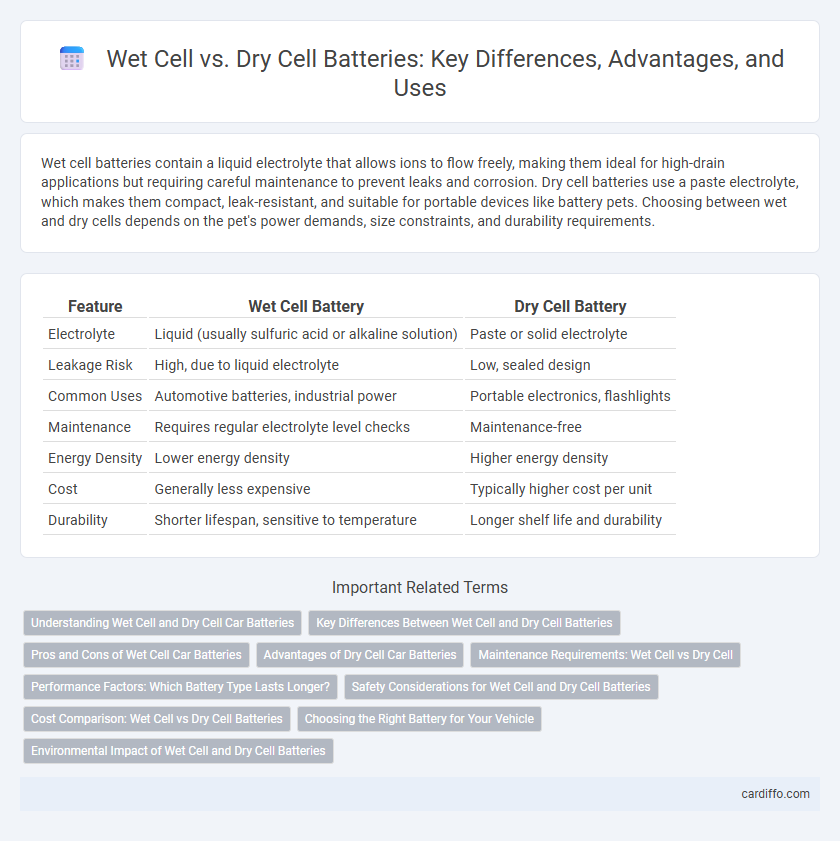Wet cell batteries contain a liquid electrolyte that allows ions to flow freely, making them ideal for high-drain applications but requiring careful maintenance to prevent leaks and corrosion. Dry cell batteries use a paste electrolyte, which makes them compact, leak-resistant, and suitable for portable devices like battery pets. Choosing between wet and dry cells depends on the pet's power demands, size constraints, and durability requirements.
Table of Comparison
| Feature | Wet Cell Battery | Dry Cell Battery |
|---|---|---|
| Electrolyte | Liquid (usually sulfuric acid or alkaline solution) | Paste or solid electrolyte |
| Leakage Risk | High, due to liquid electrolyte | Low, sealed design |
| Common Uses | Automotive batteries, industrial power | Portable electronics, flashlights |
| Maintenance | Requires regular electrolyte level checks | Maintenance-free |
| Energy Density | Lower energy density | Higher energy density |
| Cost | Generally less expensive | Typically higher cost per unit |
| Durability | Shorter lifespan, sensitive to temperature | Longer shelf life and durability |
Understanding Wet Cell and Dry Cell Car Batteries
Wet cell car batteries contain liquid electrolyte solutions that facilitate ion transfer between the positive and negative plates, providing reliable power for engine starting and accessories. Dry cell batteries use a paste electrolyte, making them more resistant to leaks and better suited for portable or sealed applications with minimal maintenance. Understanding these differences helps in selecting the right battery type for vehicle performance, longevity, and safety requirements.
Key Differences Between Wet Cell and Dry Cell Batteries
Wet cell batteries contain a liquid electrolyte, typically sulfuric acid or potassium hydroxide, enabling efficient ion transfer and higher power output but requiring maintenance to prevent leaks and corrosion. Dry cell batteries use a paste electrolyte, making them more portable, spill-proof, and suitable for everyday use in devices like flashlights and remote controls. The key differences lie in electrolyte state, maintenance needs, application suitability, and safety considerations during usage and storage.
Pros and Cons of Wet Cell Car Batteries
Wet cell car batteries offer high surge currents and are generally more affordable than dry cell batteries, making them a cost-effective choice for vehicle starting power. They require regular maintenance, including electrolyte level checks and refilling with distilled water, which can be inconvenient and pose a risk of acid spills. Wet cell batteries tend to have shorter lifespans and are more susceptible to freezing damage in cold climates compared to sealed dry cell alternatives.
Advantages of Dry Cell Car Batteries
Dry cell car batteries offer superior durability and maintenance-free operation compared to wet cell batteries, making them ideal for modern vehicles. Their sealed design prevents acid leakage and reduces the risk of corrosion, enhancing safety and longevity. Additionally, dry cells perform reliably in extreme temperatures and provide consistent power output, crucial for vehicle starting and electrical systems.
Maintenance Requirements: Wet Cell vs Dry Cell
Wet cell batteries require regular maintenance, including checking electrolyte levels and topping up with distilled water to prevent damage and ensure optimal performance. Dry cell batteries are maintenance-free, sealed units that do not require electrolyte refilling or periodic inspections, making them ideal for low-maintenance applications. The ease of use and reliability of dry cells contrasts with the hands-on upkeep necessary for wet cells in automotive and industrial settings.
Performance Factors: Which Battery Type Lasts Longer?
Wet cell batteries typically offer higher energy capacity and longer lifespan due to their liquid electrolyte, which allows for efficient ion exchange and better charge retention. Dry cell batteries are more compact and maintenance-free but generally have shorter cycle life and lower energy density because of their paste electrolyte. Performance longevity depends on specific applications, with wet cells often preferred for heavy-duty, long-term use while dry cells excel in portability and convenience.
Safety Considerations for Wet Cell and Dry Cell Batteries
Wet cell batteries require careful handling due to the presence of liquid electrolytes, which pose risks of leaks, spills, and hazardous chemical exposure. Dry cell batteries contain solid or paste electrolytes, significantly reducing the risk of leakage and making them safer for portable and consumer applications. Both types demand proper disposal methods to prevent environmental contamination and ensure user safety.
Cost Comparison: Wet Cell vs Dry Cell Batteries
Wet cell batteries generally have a lower upfront cost compared to dry cell batteries due to simpler materials and construction. However, wet cells require more maintenance and have a shorter lifespan, which can increase the total cost of ownership over time. Dry cell batteries, despite higher initial costs, offer improved durability, safety, and lower maintenance expenses, making them more cost-effective for long-term use.
Choosing the Right Battery for Your Vehicle
Wet cell batteries, also known as flooded batteries, offer high surge currents and are cost-effective, making them suitable for standard vehicles and heavy-duty applications. Dry cell batteries, or sealed batteries, require minimal maintenance and provide better resistance to vibration and temperature fluctuations, ideal for modern vehicles with demanding electrical systems. Selecting the right battery depends on your vehicle's power requirements, climate conditions, and maintenance preferences to ensure optimal performance and longevity.
Environmental Impact of Wet Cell and Dry Cell Batteries
Wet cell batteries contain liquid electrolytes that can leak toxic substances such as lead and sulfuric acid, posing significant environmental hazards during disposal and recycling. Dry cell batteries, using paste electrolytes, are less prone to leakage and generally have a smaller environmental footprint but still require proper recycling to prevent heavy metal contamination. Both battery types demand careful handling to mitigate soil and water pollution risks associated with their chemical components.
Wet Cell vs Dry Cell Infographic

 cardiffo.com
cardiffo.com